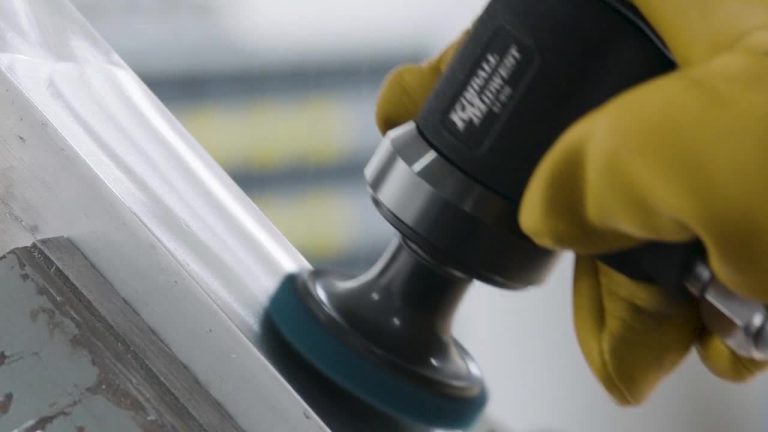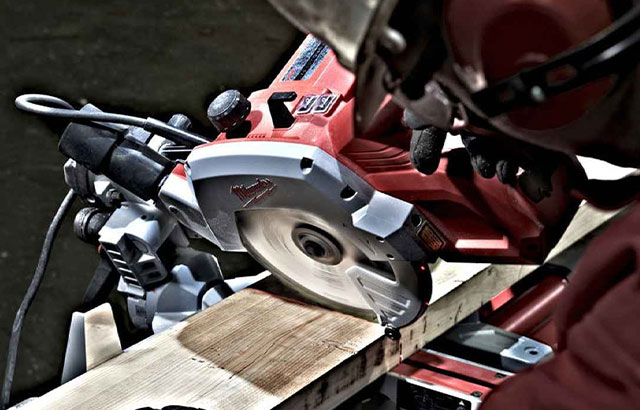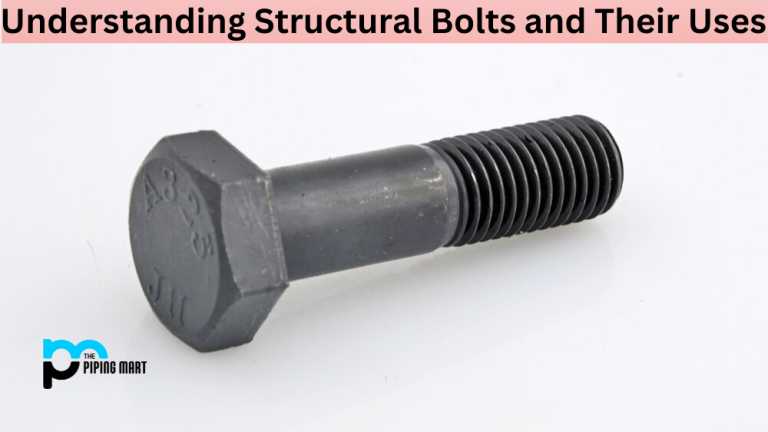How To Store A Cordless Drill Properly UK
If you have bought a cordless drill, batteries and a charger, then it is a really good idea to know how to store them properly. Cordless drills have become a popular and very useful tool for homeowners, DIY enthusiasts, and professionals alike. Their portability and convenience make them the number one choice for a wide range of tasks, from drilling holes to driving in screws.
However, like any tool, proper storage is crucial for maintaining their performance and extending their life. We will walk you through our key recommendations in this detailed article.
Preparing your cordless drill for storage
Imagine you have just finished using your drill, and you most likely quickly want to put it away quickly and relax. I know I have felt like that many times. You can always go back and tidy up later. In reality, that seldom happens. It really only takes an extra couple of minutes to store it properly. Before storing your cordless drill, it’s worthwhile doing that properly to prevent damage and ensure optimal performance when you pick it up again. Here’s my step-by-step guide:
- Clean the Drill Thoroughly: Take just a little time clean your cordless drill to remove dirt, sawdust or anything that is noticeable. You can use a soft cloth or brush to wipe down the exterior, paying attention to crevices and areas where dirt tends to accumulate. That is usually around the air vents on the housing and around the chuck area. A small sash brush is ideal for this.
- Wipe Down Battery Contacts: If you have a cordless drill, the battery contacts can corrode, Especially if the drill has been exposed to moisture or dampness. That will lead to poor connectivity and reduced performance. To stop this from happening, wipe down the battery contacts with a clean, lint-free cloth. If the corrosion is particularly bad use rubbing alcohol.
- Remove Drill or Driver Bits from the chuck: Always store drill bits or driver bits separately. That helps stop and accidental damage to the drill chuck and the bits themselves. Use a dedicated bit holder, store them in a compartment within the drill case, or in some type of organiser case..
- Dry Storage: It is really important to know that cordless drills are not designed for exposure to moisture or extreme temperatures. Try to store your drill in a dry, cool location away from direct sunlight, heat sources, and excessive humidity.
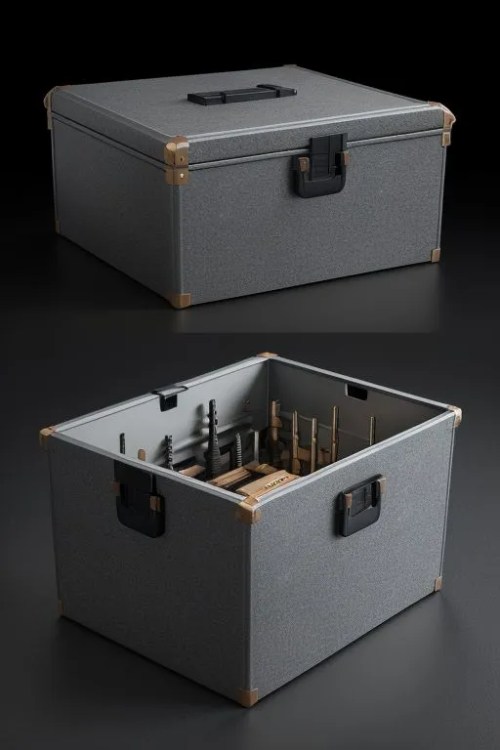
Storage Options
Once your cordless drill has been cleaned and the bits put away, then is the time to choose a suitable storage solution. Here are some popular options that are worth your consideration:
- Cordless Tool Storage Racks – These are by far the best option and what we would recommend for most people. They have convenient hanging places at the bottom of the rack where you can hang your drills. The better ones also come with a power storage station for up to four power tools, when they are not in use. Again, the better ones will have cord cutouts that allow your chargers chargers to be placed on top. They will also have storage shelves that have a multi-sized drill bit holder on the side and additional holes for bit storage.
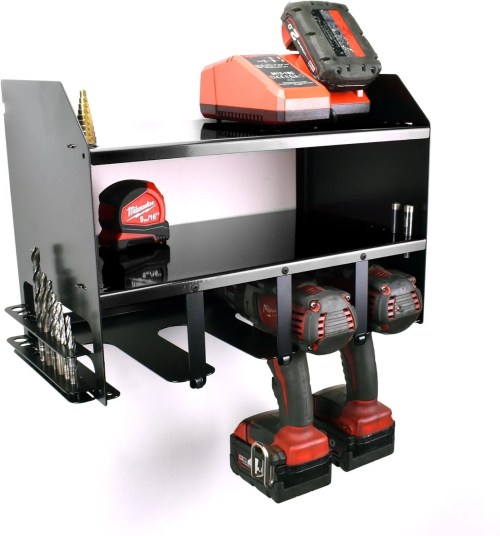
We recommend the Jbl wall mountable shelving storage unit charging station shown above. Check Amazon UK for availability. Depending on where you buy something like this, they cost around £30-£50, so good value for money. They are also easy to clean and makes finding your tools faster and easier.
- Tool Storage Case: – Hopefully, when you bought your drill, it came with some type of storage case or a bag. These have been designed to perfectly fit your drill, so make sure to use that. In most cases, that storage case is made of a really hard plastic, which is pretty tough and adds good protection. If you didn’t get a case, or want something better, then a dedicated tool storage case is the best choice for protecting your cordless drill and accessories. These cases are made of tough, durable materials like plastic or aluminum and feature compartments or dividers to keep your tools organised and prevent damage. Choose a case that fits your drill snugly and has enough space for other essential tools like drill bits, screwdrivers, and wrenches.
- Pegboard and Hooks: Lots of these exist in garages, shed and workshops throughout the UK. They are really useful, versatile and are an inexpensive storage solution for many tools. You can hang your drill on a pegboard using sturdy hooks or brackets. This type of pegboard provides easy access and visibility, making it ideal for frequently used tools. If the pegboard is in an environment prone to dampness, such as a garage without heating, then these would not be a good choice.
- Tool Rack: Tool racks are another great option for wall-mounted storage, and similar in principle to the pegboard. These racks typically have a number of slots or holders designed specifically for cordless drills and other power tools. Mount the rack at a height that allows for easy retrieval and storage.
- Shelves: If you have limited wall space, consider using shelves to store your cordless drill. Dedicate a shelf in your shed, garage, workshop, or somewhere inside the house, specifically for power tools. Ensure the shelf is sturdy enough to support the weight of your drill and other tools. You can buy shelves or have a go at making them.
Additional Storage Tips
For the very best storage and protection, consider these additional tips:
- Battery Removal: If you have a cordless drill, I would highly recommend removing the batteries after use. This really helps extend the lifespan of your batteries. It is a manufacturer recommended practice to remove them when storing the drill for extended periods. The reason for this is that it reduces the strain on the battery cells and helps prevent damage from any type of discharge.
- Upright Storage: Where possible, if you are not going to remove the battery, try to store your cordless drill in an upright position. That will at least stop the battery from shifting or becoming loose during storage.
- Desiccant Packets/Mini dehumidifier: If your only storage option is in an area with high humidity or prone to condensation and dampness, it is worth considering moisture absorbing desiccant packets to protect your cordless drill from moisture damage. You put these inside the tool storage case or near the drill on the shelf. Likewise, many people use a small disposable dehumidifier to help remove moisture from the air.
Battery Storage
If you have gone down the route of cordless tools then very quickly, you can end up with owning at least a couple of batteries and a charger or two. You will also no doubt have realised that these are expensive items to buy. They vary in price depending on the brand and the Ah rating. It is a really good idea to properly look after them.
It is also worth noting that in any cordless drill user guide, they allocate an entire section to battery safety and storage. That seldom gets read, but it is very important. Proper battery storage is crucial for maintaining their performance and extending their lifespan:
- Cool and Dry Storage: – Always store batteries in a cool, dry place away from direct sunlight and heat sources. Any type of extreme temperature, hot or cold, can damage battery cells and reduce their capacity.
- Partial Charge: – Here is a very useful tip. If you have to store batteries for an extended period, charge them to 40-50% capacity. Don’t fully charge them. This helps maintain the battery’s health and prevents deep discharge, which can damage the cells.
- Avoid Extremes: – Avoid storing batteries near ovens, refrigerators, or in outdoor unheated sheds. The temperature fluctuations in these places can damage the battery cells.
- Regularly Inspect: – Once every couple of months, inspect your batteries for any signs of damage, such as swelling, leaks, or corrosion. If you notice any damage, dispose of the batteries properly and replace them with new ones. If you own a corded drill, then check the electrical lead for any signs of wear and tear. If you find that, then it is best to replace the lead.
Maintenance Tips for Cordless Drills
Every tool you own will benefit from some care every now and then. Your cordless cordless drill is no exception and will keep it in the best condition:
- Cleaning and Lubrication: – Give your drill a quick clean after use or if it has been sitting around for a while. I would recommend a small soft to medium brush or a a soft cloth. Never use any type of harsh chemicals or abrasive cleaners. Lubricate the moving parts of the drill, such as the chuck and trigger mechanism, with a light-duty oil. The easiest way to do this is to fully open the chuck. Put a few drops of lubricant into the chuck and open and close it few times to spread the oil around. Operate the drill for about 20 seconds and then dab off any excess oil that may have splashed out. Light machine oil is best, and if you haven’t got that, then WD40 will do the job.
- Inspection for Damage: – It is always a good idea to quickly look at your drill for any signs of damage, such as cracks, loose parts, or worn-out components. If you notice any damage, have the drill repaired by a qualified technician.
- Prompt Replacement: – If any parts of your cordless drill start to become worn out or damaged, replace them promptly to prevent further damage and maintain optimal performance. Always worthwhile checking warranties first to see what is covered.
As you can see, good storage and maintenance will help extend the overall lifespan of your cordless drill, ensuring it remains a reliable tool for years to come. By following the tips and guidelines outlined in this comprehensive guide, you can keep your cordless drill in top condition and ready for any project.
Further Reading
You might also enjoy reading my articles on:
- Full Drill Buyers Guide for UK
- The Top 10 Cordless Drills in the UK
- Drill Maintenance & Cleaning
- Cordless Torque Explained for Cordless Drills
